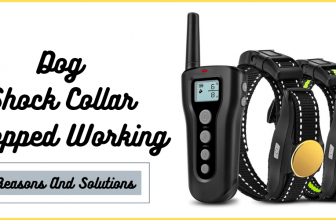Collar strengths can be adjusted to fit the size of your dog be it to reduce it or increase it. Well, increasing it can be illegal if it is more than the level the government recommends and approves.
Adjusting the collar strength delivers just the right amount of static shock to your dog. Enough to correct it but do no harm. Problems are bound to happen as you continue to use the invisible fence.
Problems such as the battery strength weakening or the wires of the invisible fence breaking or your dog developing resistance for the shock the collar delivers. Well, most of these problems happen after a long time of use. So, if you just started using an invisible fence, you need not worry much but be on the lookout.
What is invisible fence frequency?
The boundary wire runs through the boundary perimeter and meets at the transmitter where it is joined by twisted wires. The transmitter holds the signal so when the wires are connected to it, it expands the signal. Running the wire around the yard and to the transmitter forms a complete and continuous circuit.
The continuous circuit ensures that the invisible fence frequency runs at an equal rate up and down the wire. The frequency is responsible for sending signals to the collar to deliver a static shock, vibration, or tone to the collar when your dog leaves its boundary.
How To Adjust Invisible Fence Collar Strength?
So your dog has passed the boundary twice or more and you are wondering how. Or you just bought the collar and you do not know which static level is most suitable for your dog. If your dog has breached the boundary a couple of times, then there is something wrong, either with the wire or the collar. And adjustments need to be made.
But do not worry, making adjustments to fit your dog is very easy. Every collar comes with its settings and features as designed by its manufacturers.
But for this article, we’ll be using the steps for the general setting:
- First, check if the transmitter is properly connected to the twisted wires and if the twisted wires are properly connected to the boundary wire. Also check the perimeters of the boundary wire if two wires are touching each other, if you’ve checked all this and nothing wrong, love to the next.
- Using yourself to check the strength of your collar does not seem effective because you cannot measure your strength with that of your dog. So with the collar switched on and on your dog’s neck, start from the lowest level.
- Walk your dog to the boundary and watch for any change in their body. Maybe a twitch or its ears going up. If none of that happened, then he did not notice the correction. This means it is too low.
- Take your dog back into the yard and change the level of the simulation to a higher one
- Walk your dog to the boundary again and look out for the changes mentioned earlier, if you notice nothing then try again
- Keep changing the levels to a higher one until your dog gives a surprising look or his ears go up. When it finally happens, leave it at that and take your dog back to the fence. Try to increase the level anymore because doing so can stress the dog.
How to Troubleshoot an Invisible Fence?
There are times when your invisible fence fluctuates or stops working. Calling a company to repair it is a very good idea but would cost more.
Doing it yourself saves more and even helps you understand your fence more. And troubleshooting your fence involves checking for possible problems and fingers solutions to the diagnosed problem.
- Check the dog collar first. The dog collar might have gone off because the battery is dead. Or it isn’t working because it is not tight enough for the dog to feel the static shock.
- Go further by increasing the collar strength
- The next focus should be on the boundary wire. Check out the perimeter of the fence to see if there is a break in the fence. To be sure of this, with your collar in hand, walk to the boundary wire, if it does not beep, and proceed to unbury the wire.
- If you find a break in the wire, then unplug it from the transmitter and change it
Common Problems People Face with the Invisible Fence
Let’s look at possible problems that could be encountered when using an invisible fence:
- The collar fluctuates or stops working
You’ve noticed that your dog collar does not beep or deliver a shock when it is over or at the boundary, check the battery and if it is not as a result of low battery, change the battery. Any other collar problem should be checked and repaired by a professional or the manufacturers.
- The collar might be falling off
If your dog’s collar is never seen to stay on your dog’s neck then the collar is either oversized or has been chewed on by your dog to let it loose. Dogs chew on their collars when it is too tight or heavy. So if it is heavy, get a lighter collar that fits his neck size.
- Problems with Underground wire
If your dog collar works everywhere along the boundary wire and the levels of power are okay, your transmitter is fine. Any other problem could be a result of a broken wire. This mostly happens at the splices and to find this, you need some kind of tool. This tool allows you to check the wire slices and find the break without you having to dig up the boundary wire at all the places.
- Dog problems
Your dog might endure the simulation because what is outside the boundary is bigger. If your dog sees a squirrel or rabbit and badly wants to chase it, it will not mind the shock
Your dog might be having rashes, bumps, or skin irritations when using the collar. This is as a result of constantly wearing the collar or the collar being too tight. To solve this, get a collar that is designed with a nylon strap and does not allow the dog to wear it every time. You can take it off at bedtime and put it back on in the morning.
The collar should be tight enough for the dog to feel the shock but loose enough to avoid swollen skin. If it is too tight, you should adjust the strap and if it is still not loose enough, change it.
If your dog does not feel the shock the collar delivers when after you’ve adjusted the simulation levels then check your dog fur. Thin it out if it is full and long that way your dog can feel the simulation.
How Do You Change the Frequency on an Invisible Fence Collar?
It is very okay to want to change the frequency of your invisible fence collar especially when it is necessary. Changing the frequency is quite easy but it should not exceed the level recommended and authorized by the government or else it becomes a crime. This is to ensure that there is fairness in training and owning your dog.
- Remove the collar battery and back panel of the collar.
- Also, remove the back panel of the transmitter. Some pet containment transmitters come as a handheld device while others come in a form that needs to be attached to a wall or kept nailed to something inside the house.
- Check both panels for any instruction or options on how to change the frequency of the system. Older models were built with analog dials that allow you to change the frequency by either moving it up or down. If you are using models like that, lucky you. But the models of these days require another device to help digitally change the frequency.
These tips might not be the same for all invisible fences but be sure to check your manual for instructions on how to change the frequency of your invisible fence model.
How Do I Change the Intensity of my Pet Safe Collar?
Using an invisible fence keeps your dog within your yard by making a tone or sending a static shock to correct the dog. But when your dog seems to be unaffected by the simulations, increasing the intensity of the collar is an option to try.
- Press the button on the collar, a light on it will come on. Hold the button for as long as 5 seconds. Doing this will let you know the current static level.
- Press and hold again for another five seconds and this will change the correction level to a higher one. The level of correction will be indicated with the number of times the light flashes. For instance, for the 5th correction level, the light will flash 5 times.
- To be sure that the intensity is high enough, move further outside the boundary wire. You can increase the distance of the fence by using the knob or lever of the transmitter.
- Check the prongs on the collar. Some prongs are made short to fit short-haired dogs and long for long-haired dogs. Make sure to use the prong that fits your dog’s description or else it will not feel the simulation.
How Do You Test an Invisible Fence Collar?
The first thing to do is to hold the collar in your hands and close the strap-like it is on your dog’s neck. Make sure your transmitter is switched on. Holding the collar with the bottom facing down and the top of the collar between your palm, walk towards the boundary of the fence.
While walking towards the fence, hold the collar at the same level as your dog would if it were wearing it. If it is any higher than that, it might not work the way it should. This is because it was not programmed to work that high off the ground.
As you get closer to the fence, you will hear a beep-beep sound from the collar. When this happens, it means that your receiver collar is working, the battery is fully charged, the transmitter is working and the boundary wires are properly connected to the transmitter.
In case you do not hear a sound, you can check the collar with the tips of your fingers. Hold a part of the strap with the tip of your fingers to check for vibration or shock. If you feel nothing, your system may have a problem.
It is also possible that there was a beep but it was too low for you to hear. Don’t worry nothing is wrong with the collar, it is just not up to your hearing. But it could be perfect for your dog’s hearing.
How Do You Reset an Invisible Fence Collar?
So, you are not satisfied with the performance of the invisible fence and you want to change most or all of the current settings to give you the effectiveness you need. It is simple. As easy as just removing and replacing the collar battery.
While resetting the system, remove the collar from your dog and take your dog inside the house. This is so that it does not roam off without the collar. Disconnect the transmitter as well as the boundary wires connected to it.
Change the settings you want on the transmitter and the collar and test it. Testing it is to ensure that your dog fence has been set the way you want it to be.
Conclusion:
Having problems with devices is a norm. While some might need professional help, some just need to be touched or shaken. Not to say that when your collar is having a problem you should slap or shake it. That is a bad idea, it might increase the problem and you do not want that.
With the help of the steps mentioned above, I hope you find it easy to work with your invisible fence.








